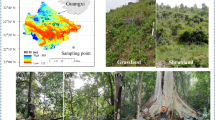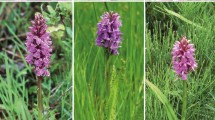Abstract
The African baobab is the biggest and longest-living angiosperm tree. By using radiocarbon dating we identified the stable architectures that enable baobabs to reach large sizes and great ages. We report that 9 of the 13 oldest and 5 of the 6 largest individuals have died, or at least their oldest parts/stems have collapsed and died, over the past 12 years; the cause of the mortalities is still unclear.

Similar content being viewed by others
Change history
02 July 2018
In Supplementary Table 1 originally published with this Brief Communication, the authors gave an incorrect GPS easterly coordinate for tree number 12 (Makulu Makete Big baobab); the coordinate ‘2° 34.584' S, 25° 52.261' E’ should have read ‘22° 34.584' S, 28° 52.261' E’. This has now been amended in the online Supplementary Information file for this Brief Communication.
References
Wickens, G. E. & Lowe, P. The Baobabs: Pachycauls of Africa, Madagascar and Australia (Springer, Dordrecht, 2008).
Wickens, G. E. Kew Bull. 47, 173–209 (1983).
Baum, D. A. Ann. Mo. Bot. Gard. 82, 440–471 (1995).
Patrut, A. et al. Ann. For. Sci. 68, 993–1003 (2011).
Patrut, A., von Reden, K. F., Mayne, D. H., Lowy, D. A. & Patrut, R. T. Nucl. Instrum. Methods Phys. Rev. B 294, 622–626 (2013).
Patrut, A. et al. PLoS ONE 10, e0117193 (2015).
Patrut, A. et al. Radiocarbon 59, 435–448 (2017).
Patrut, A. et al. Tree Physiol. 27, 1569–1574 (2007).
Alexander, J., McGregor, J. A. & Ranger, T. Violence & Memory, One Hundred Years in the ‘Dark Forests’ of Matabeleland (Currey, Oxford, 2000).
Mullin, L. J. Historic Trees of Zimbabwe (CBC, Bath, 2003).
Patrut, A. et al. Radiocarbon 52, 717–726 (2010).
Engelbrecht, F. et al. Environ. Res. Lett. 10, 085004 (2015).
Bronk Ramsey, C. et al. Radiocarbon 51, 337–360 (2009).
Hogg, A. G. et al. Radiocarbon 55, 1889–1903 (2013).
Acknowledgements
The investigation and collection of samples from the trees was approved and authorised by the South African National Parks, the Kruger National Park, the Mapungubwe National Park, the Ministry of Environment and Tourism of Namibia and the Department of Wildlife and National Parks of Botswana, the South Luangwa National Park. We thank H. and D. van Heerden, P. Philips and J. Chidgey, C. and Y. Liversage, L. Duplessis and R. and A. Whittall for granting permission for on-site investigation of baobabs located on their private lands. We also thank D.H. Mayne, M. Hofmeyr, S. Venter, A. Alberts, R. Wittmann, D. Dube and O. (Leon) Tsamkgao for helping to obtain permits and for participating at several field investigations. Special thanks go to J. Alexander for providing the photograph of Panke. This research was supported by the Romanian Ministry of National Education CNCS-UEFISCDI under grant PN-II-ID-PCE-2013-76 and by the Romanian Ministry of Research and Innovation CNCS-UEFISCDI under grant PN-III-P4-ID-PCE-2016-0776, no. 90/2017.
Author information
Authors and Affiliations
Contributions
A.P. conceived the research. A.P., S.W., R.T.P., L.R. and G.H. performed field investigations and collected samples. K.F.v.R. performed AMS measurements. A.P., S.W., R.T.P. and D.A.L. interpreted results and wrote the manuscript.
Corresponding author
Ethics declarations
Competing interests
The authors declare no competing interests.
Additional information
Publisher’s note: Springer Nature remains neutral with regard to jurisdictional claims in published maps and institutional affiliations.
Supplementary information
Supplementary Information
Supplementary Figs. 1–3, Supplementary Tables 1 and 2
Rights and permissions
About this article
Cite this article
Patrut, A., Woodborne, S., Patrut, R.T. et al. The demise of the largest and oldest African baobabs. Nature Plants 4, 423–426 (2018). https://doi.org/10.1038/s41477-018-0170-5
Received:
Accepted:
Published:
Issue Date:
DOI: https://doi.org/10.1038/s41477-018-0170-5
- Springer Nature Limited
This article is cited by
-
Baobabs as symbols of resilience
Nature Plants (2024)
-
Ancient, veteran and other listed trees as nest sites for wild-living honey bee, Apis mellifera, colonies
Journal of Insect Conservation (2024)
-
Human activities and species biological traits drive the long-term persistence of old trees in human-dominated landscapes
Nature Plants (2023)
-
A Historically Contextualized Account of the Baobab Trees (Adansonia digitata L.) of Tobago
Economic Botany (2022)
-
Search strategies
Nature Plants (2021)





